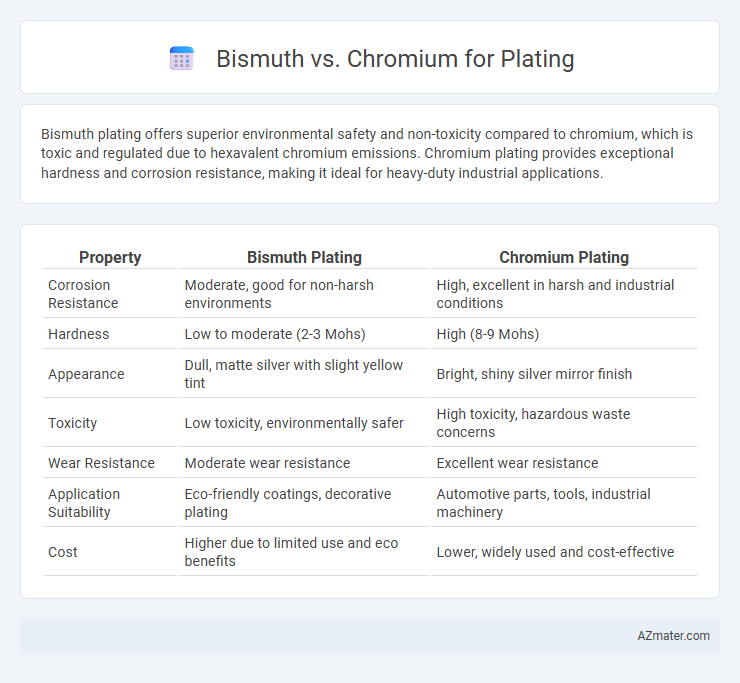Bismuth plating offers superior environmental safety and non-toxicity compared to chromium, which is toxic and regulated due to hexavalent chromium emissions. Chromium plating provides exceptional hardness and corrosion resistance, making it ideal for heavy-duty industrial applications.
Table of Comparison
| Property | Bismuth Plating | Chromium Plating |
|---|---|---|
| Corrosion Resistance | Moderate, good for non-harsh environments | High, excellent in harsh and industrial conditions |
| Hardness | Low to moderate (2-3 Mohs) | High (8-9 Mohs) |
| Appearance | Dull, matte silver with slight yellow tint | Bright, shiny silver mirror finish |
| Toxicity | Low toxicity, environmentally safer | High toxicity, hazardous waste concerns |
| Wear Resistance | Moderate wear resistance | Excellent wear resistance |
| Application Suitability | Eco-friendly coatings, decorative plating | Automotive parts, tools, industrial machinery |
| Cost | Higher due to limited use and eco benefits | Lower, widely used and cost-effective |
Introduction to Metal Plating
Metal plating involves depositing a thin layer of metal onto a substrate to enhance corrosion resistance, appearance, and durability. Bismuth offers eco-friendly plating solutions with low toxicity and good wear resistance, serving as an alternative to traditional heavy metals. Chromium plating, known for its hardness, corrosion resistance, and bright finish, remains a popular choice for decorative and industrial applications despite environmental concerns related to hexavalent chromium.
Overview of Bismuth Plating
Bismuth plating offers excellent corrosion resistance and is valued for its environmentally friendly, non-toxic properties compared to traditional heavy metals like chromium. This plating provides a unique combination of low toxicity, high lubricity, and good electrical conductivity, making it suitable for aerospace, electronics, and medical applications. Unlike chromium plating, bismuth coatings reduce environmental hazards and compliance costs while maintaining durability and wear resistance.
Overview of Chromium Plating
Chromium plating provides a durable, corrosion-resistant finish widely used in automotive, industrial, and decorative applications due to its high hardness and excellent wear resistance. It offers superior resistance to tarnishing and maintains a bright, reflective surface under harsh environmental conditions. Compared to bismuth plating, chromium plating ensures longer-lasting protection and enhanced structural integrity in heavy-use scenarios.
Physical Properties: Bismuth vs Chromium
Bismuth exhibits low density at 9.78 g/cm3 and a melting point of 271.5degC, providing moderate corrosion resistance but low hardness compared to chromium. Chromium, with a higher density of 7.19 g/cm3 and melting point of 1907degC, offers exceptional hardness, high tensile strength, and superior corrosion and wear resistance, making it ideal for durable plating. The significant difference in hardness and melting points between bismuth and chromium directly influences their suitability for plating applications that demand either softness and low toxicity or hardness and durability.
Corrosion Resistance Comparison
Bismuth plating offers superior corrosion resistance compared to chromium, especially in acidic and saline environments, due to its inert and non-toxic properties. Chromium plating, while providing excellent hardness and scratch resistance, tends to form a passive oxide layer that can degrade under prolonged exposure to corrosive agents. Bismuth's ability to resist oxidation and prevent galvanic corrosion makes it a preferred choice for applications requiring enhanced longevity in harsh conditions.
Environmental and Health Considerations
Bismuth plating offers a non-toxic and environmentally friendly alternative to traditional chromium plating, which commonly involves hexavalent chromium, a known carcinogen with significant health risks and regulatory restrictions. Bismuth compounds show lower toxicity and reduced environmental impact, making them suitable for industries aiming to comply with strict environmental regulations such as REACH and OSHA standards. Chromium plating requires extensive safety measures and waste treatment to mitigate harmful chromium(VI) exposure, whereas bismuth plating simplifies compliance with sustainability and workplace safety goals.
Aesthetic and Finish Quality
Bismuth plating offers a unique iridescent finish with excellent corrosion resistance and a smooth, non-toxic surface ideal for decorative applications. Chromium plating provides a high-gloss, reflective coating with superior hardness and wear resistance, making it popular for automotive and industrial parts. While bismuth excels in aesthetic variation and environmental safety, chromium ensures durable, mirror-like finishes with long-lasting luster.
Cost Analysis: Bismuth vs Chromium
Bismuth plating presents a cost-effective alternative to chromium due to its lower raw material and processing expenses, making it suitable for applications requiring corrosion resistance with budget constraints. Chromium plating involves higher costs associated with hazardous waste management and strict environmental regulations, increasing overall expenses. The cost difference becomes significant in large-scale industrial applications where sustainability and budget efficiency are critical factors.
Applications in Industry
Bismuth plating offers excellent corrosion resistance and environmental benefits, making it ideal for electronics and pharmaceutical industries where non-toxicity and electrical conductivity are crucial. Chromium plating provides superior hardness, wear resistance, and a decorative finish, widely used in automotive parts, aerospace components, and heavy machinery for durability under harsh conditions. Industrial applications favor bismuth for green manufacturing solutions, while chromium remains dominant in surface protection and aesthetic enhancement.
Future Trends and Innovations in Plating
Bismuth plating is gaining attention as an eco-friendly alternative to chromium due to its non-toxic properties and excellent corrosion resistance, aligning with stricter environmental regulations and sustainability goals in industrial applications. Innovations in nano-structured bismuth coatings offer enhanced hardness and wear resistance, positioning bismuth as a competitive choice for future high-performance plating solutions. Research into hybrid bismuth-chromium composite coatings aims to combine chromium's durability with bismuth's environmental benefits, driving advancements in plating technologies for automotive, aerospace, and electronics industries.

Infographic: Bismuth vs Chromium for Plating
 azmater.com
azmater.com